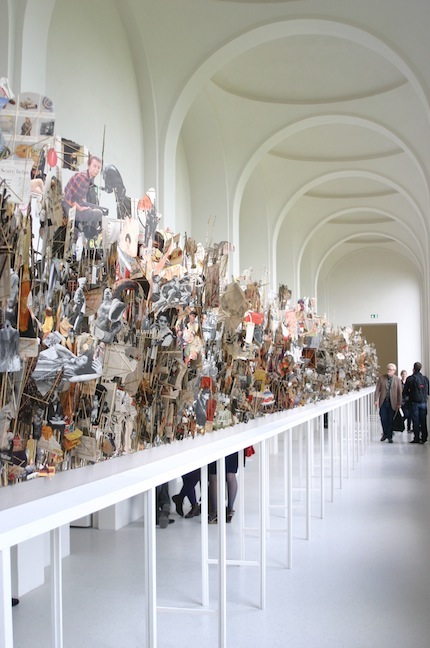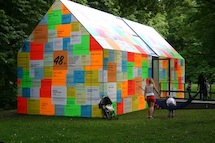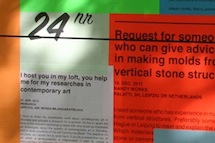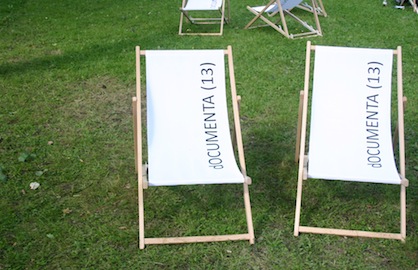
A Compost Pile
15/06/2012
Photo: Katrīna Ģelze
This summer, all roads lead to Kassel. From June 9 to September 16, the smallish German city of Kassel will host dOCUMENTA(13), which, due to its unchanging number of days open, is also often called “The 100-Day Museum”. Over 150 artists, from more than 55 countries, make up only half of the participants; a slew of biologists, physicists, authors and other experts in their field are also involved. “Interdisciplinary art bores me,” admits the exhibition's artistic director, Carolyn Christov-Bakargiev. Instead, she has chosen to invite specialists that are well-versed in their fields – not interdisciplinary drifters, to accompany the artists. It is predicted that this year's event will draw 750,000 visitors, which is the same number that attended the last dOCUMENTA, in 2007.
Did dOCUMENTA(13) make any unexpectedly new proclamations? That's the question that keeps flitting around my mind after visiting this huge organism of an exhibition. One could say that something of the sort could have been anticipated – heading off to see such a large event that's held only once every five years, and which practically demands its status as a measuring stick of contemporary art. Not always does the scene manage to drastically change in this period, but five years is certainly long enough that the previous dOCUMENTA should be shelved away well into the past, leaving one to hope for something new again.
Head curator Carolyn Christov-Bakargiev has managed to decisively capture both the zeitgeist and pertinent issues of the times, and put them into the exhibition's conceptual backbone. In keeping with this bodily metaphor, I'd have to say – nothing surprisingly new was to be seen; dOCUMENTA(13) was more like a festering case of walking-pneumonia that has finally become a full-blown case, and it's finally time to take notice – in other words, the atrophying of a quality life in today's fragmentary Age of The Internet. Immediately, two discrete emotions took hold: suspicion, because as you'll agree, the topic is a bit banal; and contemplation, because the art works do touch on painful issues, speaking to everyone who's ever been caught up in “the rat race”.
Geoffrey Farmer (1967). “Leaves of Grass”. 2012
Although the press has focused on the inclusion of scientists when describing the event, the central axis about which dOCUMENTA(13) has grouped itself seems to be – time. In most of the works, one can see insinuations of returning to the here and now, in your body, in a definite place. In essence, a reciprocal action to the digital era, in which anyone can go anywhere their heart desires, at any time. While not denying the conveniences that technology has given us, Carolyn speaks about their side-effects and the sad paradox. “Access to information seems unrestrained, until experience becomes ever-more fragmentary,” she writes in the press release, which is actually an essay on 14 pages. And art has an essential role here – to make us linger. Even the world “sprinter” and always-in-motion Swiss curator, Hans Ulrich Obrist, has many a time admitted that only art allows him opportunity to stop, because it demands undivided attention and immersion. It is notable that on the occasion of Documenta 2 in 1959, one of the exhibition's founders, Werner Haftmann, wrote: “For I would wish that Documenta should not only be a convenient pretense for aesthetic discussions and information, but equally a means of becoming acquainted with inner proceedings and their solution – as a kind of self-interrogation for the public as well as the artist.”
The curator's conception of dOCUMENTA(13) reveals itself in the works by highlighting the hand-made and crafting skills (a victory for tapestries!), using handwritten text, and not hiding sketches made during the creative process. The “hand-made” rebelling against the acceleration of daily life. Time is reflected in the most various of ways. The project by e-flux, “Time/Bank”, which was started three years ago, brings to the forefront the issue of alternative currencies. A literal play on the capitalistic mantra of “time is money”, everyone's personal time is transformed into a monetary form that can be given to anyone. Maybe you can buy yourself lunch by baby-sitting somebody's kids for a while? Whereas the South African artist William Kentridge (1955), in his work “The Refusal of Time” (2012), looks at the relativity of time and the possible ways in which it can be measured.
The issues delineated by Carolyn Christov-Bakargiev resound with the philosophic position that is especially active today. Called embodied cognition, it emphasizes the role that the body plays in the formation of subjective, cognitive and whole experiences which, in this era of digital technology, could quite possibly be endangered. The capacity of the human body dictates its own thresholds of possibility, which are then broken by the innumerable possibilities that appear, as by something as simple as turning on Google Search.
Advertising wall by e-flux project. Click on images to view them full size
“I don't have a unified concept,” Carolyn declared at the press conference. And wandering among the slightly chaotic exhibition where, at times, the selection and combination of works isn't quite thoroughly comprehensible, this can be truly felt. At the same time, in her essay on dOCUMENTA(13), she explains that “every step of the way, everyone must understand that something fundamental is not being told; it is unseen and missing – memories, an unanswered question, doubt. What can be seen in the exhibition halls will always be accompanied by some ghost.” The “ghost” that she alludes to is a 12th century Benedictine monastery in Kassel, where during the time of the Nazis, there used to be a concentration camp; now it is a WWII memorial and a psychiatric hospital. Although this place is not one of the spots on the map of the exhibition route, every dOCUMENTA(13) participant was assigned to visit the site before they started sketching out their ideas. Carolyn describes the place as the subconscious of the exhibition, a parallel world where, throughout the years, the spirit has been suppressed in a myriad of ways – in physical, sexual, psychological and creative terms. It's hard to say whether or not it was due to this emotionally saturated “excursion”, but side-by-side with the chaotic, a slew of the exhibited works exuded an aftertaste of “realness” that didn't wear off for many days after viewing dOCUMENTA(13). As if the artists stopped talking about the superficial, ceased to be sleepy and content, but knew how to speak to the viewer.
Somehow, dOCUMENTA(13) is reminiscent of a compost pile, but in a good sense. This association is founded on its various layers, in which there are works from both the beginning of the 20th century, and those made just this year; contributions from artists and scientists; both well-known players in the art world, and those completely yet unheard-of; a wide array of participating countries; the pushing to the side of anthropocentricity – placing the living things of Earth, including the plant kingdom, on one egalitarian plane. All together, it's a bit of a mess, but they coexists holistically and in the end, they create a single, fertile soil. We just have to wait and see what kind of flora will germinate, and what kind of fauna will populate it.



